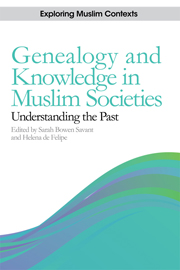Book contents
- Frontmatter
- Contents
- List of Figures and Tables
- Introduction
- Part One The Generation of Genealogical Knowledge
- Part Two Empowering Political and Religious Elites
- 4 Berber Leadership and Genealogical Legitimacy: The Almoravid Case
- 5 Ways of Connecting with the Past: Genealogies in Nasrid Granada
- 6 Embarrassing Cousins: Genealogical Conundrums in the Central Sahara
- Part Three Genealogy as a Source for Writing History
- About the Contributors
- Index
4 - Berber Leadership and Genealogical Legitimacy: The Almoravid Case
from Part Two - Empowering Political and Religious Elites
Published online by Cambridge University Press: 05 September 2014
- Frontmatter
- Contents
- List of Figures and Tables
- Introduction
- Part One The Generation of Genealogical Knowledge
- Part Two Empowering Political and Religious Elites
- 4 Berber Leadership and Genealogical Legitimacy: The Almoravid Case
- 5 Ways of Connecting with the Past: Genealogies in Nasrid Granada
- 6 Embarrassing Cousins: Genealogical Conundrums in the Central Sahara
- Part Three Genealogy as a Source for Writing History
- About the Contributors
- Index
Summary
They only knew the desert and had never seen a city. Neither did they know of wheat, barley or flour. They ate dairy products and, occasionally, meat. They rode camels and were brave and bold. That was how Ibn Hawqal, the famous tenth-century Muslim geographer, described the tribes living between Aoudaghost and Sijilmasa in the south of the Maghrib. Several of these tribes, including the Sanhaja, were part of the Almoravid movement and, within a short time, made the transition from the arid African sands and the lifestyle mentioned above to a structure with a political-military leader, Yusuf ibn Tashfin (r. 1061–1106), whose forces fought against the Castilian King Alfonso VI (r. 1072–1109) and who ruled over a vast territory in the Islamic West.
The Almoravids played a key role in the expansion and defence of Islam in the Islamic West, and they controlled a territory, West Africa, where this religion was disseminated, as well as another region, al-Andalus, where it was necessary to defend the religion against the advances of the Christian kings from the north. The development of the Almoravid movement from the union of the tribes within it to the establishment of a power structure based on a dynastic order took place over about a century (from the mid-eleventh century to the mid-twelfth) and, among other important events, brought about the founding of the city of Marrakesh.
- Type
- Chapter
- Information
- Genealogy and Knowledge in Muslim SocietiesUnderstanding the Past, pp. 55 - 70Publisher: Edinburgh University PressPrint publication year: 2014

